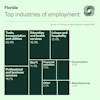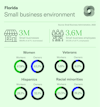 Stephanie Ferguson Melhorn
Stephanie Ferguson Melhorn
Executive Director, Workforce & International Labor Policy, U.S. Chamber of Commerce
Published
November 03, 2023
The state of Florida has a favorable landscape for businesses and individuals, with a diverse economy, improving labor market, and a robust small business ecosystem. Immigrants contribute meaningfully to the state's workforce and economy, while educational attainment, quality of life, and cost of living factors remain promising.
The Worker Shortage Across America
Explore the interactive map below to see the impact of the worker shortage crisis in each state.
Alabama
-
0.73
Alabama's Worker Shortage Index
- Job Openings: 108,000
- Unemployed Workers: 78,740
- Labor Force Participation Rate: 57.9%
- Unemployment Rate: 3.3%
- Quit Rate: 2.2%
- Hiring Rate: 3.6%
Alaska
-
0.85
Alaska's Worker Shortage Index
- Job Openings: 20,000
- Unemployed Workers: 17,067
- Labor Force Participation Rate: 65.2%
- Unemployment Rate: 4.7%
- Quit Rate: 2.7%
- Hiring Rate: 5.3%
Arizona
-
0.90
Arizona's Worker Shortage Index
- Job Openings: 170,000
- Unemployed Workers: 153,827
- Labor Force Participation Rate: 61.5%
- Unemployment Rate: 4.1%
- Quit Rate: 2.0%
- Hiring Rate: 3.6%
Arkansas
-
0.69
Arkansas's Worker Shortage Index
- Job Openings: 76,000
- Unemployed Workers: 52,230
- Labor Force Participation Rate: 58.4%
- Unemployment Rate: 3.7%
- Quit Rate: 2.3%
- Hiring Rate: 3.8%
California
-
1.60
California's Worker Shortage Index
- Job Openings: 659,000
- Unemployed Workers: 1,054,992
- Labor Force Participation Rate: 62.2%
- Unemployment Rate: 5.3%
- Quit Rate: 2.0%
- Hiring Rate: 2.8%
Colorado
-
1.09
Colorado's Worker Shortage Index
- Job Openings: 145,000
- Unemployed Workers: 158,688
- Labor Force Participation Rate: 67.8%
- Unemployment Rate: 4.8%
- Quit Rate: 2.1%
- Hiring Rate: 4.5%
Connecticut
-
0.99
Connecticut's Worker Shortage Index
- Job Openings: 73,000
- Unemployed Workers: 72,232
- Labor Force Participation Rate: 65.0%
- Unemployment Rate: 3.7%
- Quit Rate: 2.1%
- Hiring Rate: 3.1%
Delaware
-
0.89
Delaware's Worker Shortage Index
- Job Openings: 22,000
- Unemployed Workers: 19,598
- Labor Force Participation Rate: 58.9%
- Unemployment Rate: 3.9%
- Quit Rate: 2.2%
- Hiring Rate: 3.6%
District of Columbia
-
0.90
District of Columbia's Worker Shortage Index
- Job Openings: 27,000
- Unemployed Workers: 24,409
- Labor Force Participation Rate: 72.4%
- Unemployment Rate: 5.8%
- Quit Rate: 1.8%
- Hiring Rate: 2.3%
Florida
-
0.95
Florida's Worker Shortage Index
- Job Openings: 433,000
- Unemployed Workers: 410,460
- Labor Force Participation Rate: 58.0%
- Unemployment Rate: 3.7%
- Quit Rate: 2.4%
- Hiring Rate: 3.5%
Georgia
-
0.72
Georgia's Worker Shortage Index
- Job Openings: 266,000
- Unemployed Workers: 191,739
- Labor Force Participation Rate: 60.8%
- Unemployment Rate: 3.6%
- Quit Rate: 2.2%
- Hiring Rate: 3.7%
Hawaii
-
0.79
Hawaii's Worker Shortage Index
- Job Openings: 25,000
- Unemployed Workers: 19,655
- Labor Force Participation Rate: 60.5%
- Unemployment Rate: 2.9%
- Quit Rate: 1.8%
- Hiring Rate: 3.2%
Idaho
-
0.87
Idaho's Worker Shortage Index
- Job Openings: 43,000
- Unemployed Workers: 37,300
- Labor Force Participation Rate: 63.6%
- Unemployment Rate: 3.7%
- Quit Rate: 2.6%
- Hiring Rate: 4.4%
Illinois
-
1.11
Illinois's Worker Shortage Index
- Job Openings: 291,000
- Unemployed Workers: 321,693
- Labor Force Participation Rate: 64.9%
- Unemployment Rate: 4.8%
- Quit Rate: 2.4%
- Hiring Rate: 3.2%
Indiana
-
0.88
Indiana's Worker Shortage Index
- Job Openings: 153,000
- Unemployed Workers: 134,329
- Labor Force Participation Rate: 63.7%
- Unemployment Rate: 3.9%
- Quit Rate: 2.9%
- Hiring Rate: 4.6%
Iowa
-
0.90
Iowa's Worker Shortage Index
- Job Openings: 67,000
- Unemployed Workers: 60,570
- Labor Force Participation Rate: 67.2%
- Unemployment Rate: 3.5%
- Quit Rate: 2.6%
- Hiring Rate: 3.5%
Kansas
-
0.82
Kansas's Worker Shortage Index
- Job Openings: 73,000
- Unemployed Workers: 59,664
- Labor Force Participation Rate: 67.1%
- Unemployment Rate: 3.8%
- Quit Rate: 2.4%
- Hiring Rate: 3.4%
Kentucky
-
1.08
Kentucky's Worker Shortage Index
- Job Openings: 101,000
- Unemployed Workers: 109,315
- Labor Force Participation Rate: 58.4%
- Unemployment Rate: 5.2%
- Quit Rate: 2.0%
- Hiring Rate: 3.6%
Louisiana
-
0.93
Louisiana's Worker Shortage Index
- Job Openings: 98,000
- Unemployed Workers: 91,053
- Labor Force Participation Rate: 57.9%
- Unemployment Rate: 4.4%
- Quit Rate: 2.3%
- Hiring Rate: 3.9%
Maine
-
0.88
Maine's Worker Shortage Index
- Job Openings: 28,000
- Unemployed Workers: 24,509
- Labor Force Participation Rate: 60.1%
- Unemployment Rate: 3.5%
- Quit Rate: 2.3%
- Hiring Rate: 3.6%
Maryland
-
0.76
Maryland's Worker Shortage Index
- Job Openings: 133,000
- Unemployed Workers: 100,476
- Labor Force Participation Rate: 64.8%
- Unemployment Rate: 3.1%
- Quit Rate: 2.1%
- Hiring Rate: 3.2%
Massachusetts
-
1.22
Massachusetts's Worker Shortage Index
- Job Openings: 148,000
- Unemployed Workers: 180,846
- Labor Force Participation Rate: 66.7%
- Unemployment Rate: 4.6%
- Quit Rate: 1.8%
- Hiring Rate: 3.2%
Michigan
-
1.24
Michigan's Worker Shortage Index
- Job Openings: 225,000
- Unemployed Workers: 277,879
- Labor Force Participation Rate: 62.0%
- Unemployment Rate: 5.5%
- Quit Rate: 2.1%
- Hiring Rate: 4.5%
Minnesota
-
0.53
Minnesota's Worker Shortage Index
- Job Openings: 187,000
- Unemployed Workers: 100,039
- Labor Force Participation Rate: 68.2%
- Unemployment Rate: 3.2%
- Quit Rate: 2.1%
- Hiring Rate: 3.5%
Mississippi
-
0.85
Mississippi's Worker Shortage Index
- Job Openings: 61,000
- Unemployed Workers: 52,084
- Labor Force Participation Rate: 56.2%
- Unemployment Rate: 4.0%
- Quit Rate: 2.1%
- Hiring Rate: 3.5%
Missouri
-
0.86
Missouri's Worker Shortage Index
- Job Openings: 145,000
- Unemployed Workers: 124,132
- Labor Force Participation Rate: 63.4%
- Unemployment Rate: 3.9%
- Quit Rate: 2.1%
- Hiring Rate: 3.1%
Montana
-
0.54
Montana's Worker Shortage Index
- Job Openings: 29,000
- Unemployed Workers: 15,697
- Labor Force Participation Rate: 62.3%
- Unemployment Rate: 2.7%
- Quit Rate: 3.0%
- Hiring Rate: 4.9%
Nebraska
-
0.66
Nebraska's Worker Shortage Index
- Job Openings: 49,000
- Unemployed Workers: 32,249
- Labor Force Participation Rate: 69.3%
- Unemployment Rate: 3.0%
- Quit Rate: 2.1%
- Hiring Rate: 3.6%
Nevada
-
1.38
Nevada's Worker Shortage Index
- Job Openings: 68,000
- Unemployed Workers: 93,534
- Labor Force Participation Rate: 62.9%
- Unemployment Rate: 5.6%
- Quit Rate: 2.1%
- Hiring Rate: 3.8%
New Hampshire
-
0.83
New Hampshire's Worker Shortage Index
- Job Openings: 29,000
- Unemployed Workers: 24,170
- Labor Force Participation Rate: 65.7%
- Unemployment Rate: 3.1%
- Quit Rate: 2.0%
- Hiring Rate: 3.4%
New Jersey
-
1.10
New Jersey's Worker Shortage Index
- Job Openings: 213,000
- Unemployed Workers: 234,394
- Labor Force Participation Rate: 63.9%
- Unemployment Rate: 4.8%
- Quit Rate: 1.7%
- Hiring Rate: 3.5%
New Mexico
-
0.96
New Mexico's Worker Shortage Index
- Job Openings: 44,000
- Unemployed Workers: 42,131
- Labor Force Participation Rate: 57.8%
- Unemployment Rate: 4.3%
- Quit Rate: 2.1%
- Hiring Rate: 3.4%
New York
-
0.95
New York's Worker Shortage Index
- Job Openings: 430,000
- Unemployed Workers: 410,366
- Labor Force Participation Rate: 61.0%
- Unemployment Rate: 4.2%
- Quit Rate: 1.5%
- Hiring Rate: 2.8%
North Carolina
-
0.77
North Carolina's Worker Shortage Index
- Job Openings: 255,000
- Unemployed Workers: 196,360
- Labor Force Participation Rate: 59.6%
- Unemployment Rate: 3.7%
- Quit Rate: 2.0%
- Hiring Rate: 3.0%
North Dakota
-
0.46
North Dakota's Worker Shortage Index
- Job Openings: 24,000
- Unemployed Workers: 11,009
- Labor Force Participation Rate: 69.5%
- Unemployment Rate: 2.6%
- Quit Rate: 2.4%
- Hiring Rate: 3.8%
Ohio
-
0.98
Ohio's Worker Shortage Index
- Job Openings: 296,000
- Unemployed Workers: 291,306
- Labor Force Participation Rate: 62.7%
- Unemployment Rate: 4.9%
- Quit Rate: 2.2%
- Hiring Rate: 3.4%
Oklahoma
-
0.69
Oklahoma's Worker Shortage Index
- Job Openings: 93,000
- Unemployed Workers: 64,249
- Labor Force Participation Rate: 62.6%
- Unemployment Rate: 3.2%
- Quit Rate: 2.3%
- Hiring Rate: 3.6%
Oregon
-
1.12
Oregon's Worker Shortage Index
- Job Openings: 92,000
- Unemployed Workers: 103,325
- Labor Force Participation Rate: 62.7%
- Unemployment Rate: 4.7%
- Quit Rate: 2.1%
- Hiring Rate: 3.3%
Pennsylvania
-
0.96
Pennsylvania's Worker Shortage Index
- Job Openings: 265,000
- Unemployed Workers: 255,589
- Labor Force Participation Rate: 61.6%
- Unemployment Rate: 3.9%
- Quit Rate: 1.5%
- Hiring Rate: 2.7%
Rhode Island
-
1.31
Rhode Island's Worker Shortage Index
- Job Openings: 22,000
- Unemployed Workers: 28,829
- Labor Force Participation Rate: 63.8%
- Unemployment Rate: 4.9%
- Quit Rate: 2.1%
- Hiring Rate: 3.5%
South Carolina
-
0.91
South Carolina's Worker Shortage Index
- Job Openings: 117,000
- Unemployed Workers: 106,498
- Labor Force Participation Rate: 57.5%
- Unemployment Rate: 4.2%
- Quit Rate: 2.3%
- Hiring Rate: 4.0%
South Dakota
-
0.41
South Dakota's Worker Shortage Index
- Job Openings: 22,000
- Unemployed Workers: 9,049
- Labor Force Participation Rate: 68.9%
- Unemployment Rate: 1.8%
- Quit Rate: 2.8%
- Hiring Rate: 3.8%
Tennessee
-
0.73
Tennessee's Worker Shortage Index
- Job Openings: 167,000
- Unemployed Workers: 122,290
- Labor Force Participation Rate: 59.7%
- Unemployment Rate: 3.5%
- Quit Rate: 2.3%
- Hiring Rate: 3.7%
Texas
-
1.15
Texas's Worker Shortage Index
- Job Openings: 558,000
- Unemployed Workers: 642,922
- Labor Force Participation Rate: 64.9%
- Unemployment Rate: 4.1%
- Quit Rate: 2.3%
- Hiring Rate: 3.7%
Utah
-
0.76
Utah's Worker Shortage Index
- Job Openings: 76,000
- Unemployed Workers: 57,518
- Labor Force Participation Rate: 68.3%
- Unemployment Rate: 3.1%
- Quit Rate: 2.2%
- Hiring Rate: 3.8%
Vermont
-
0.73
Vermont's Worker Shortage Index
- Job Openings: 13,000
- Unemployed Workers: 9,426
- Labor Force Participation Rate: 65.1%
- Unemployment Rate: 2.7%
- Quit Rate: 2.2%
- Hiring Rate: 3.8%
Virginia
-
0.69
Virginia's Worker Shortage Index
- Job Openings: 221,000
- Unemployed Workers: 151,942
- Labor Force Participation Rate: 65.4%
- Unemployment Rate: 3.3%
- Quit Rate: 2.1%
- Hiring Rate: 3.3%
Washington
-
1.28
Washington's Worker Shortage Index
- Job Openings: 140,000
- Unemployed Workers: 179,187
- Labor Force Participation Rate: 62.7%
- Unemployment Rate: 4.4%
- Quit Rate: 1.5%
- Hiring Rate: 3.0%
West Virginia
-
0.84
West Virginia's Worker Shortage Index
- Job Openings: 35,000
- Unemployed Workers: 29,441
- Labor Force Participation Rate: 54.3%
- Unemployment Rate: 3.8%
- Quit Rate: 2.5%
- Hiring Rate: 3.5%
Wisconsin
-
0.71
Wisconsin's Worker Shortage Index
- Job Openings: 146,000
- Unemployed Workers: 103,411
- Labor Force Participation Rate: 65.5%
- Unemployment Rate: 3.3%
- Quit Rate: 2.1%
- Hiring Rate: 3.5%
Wyoming
-
0.69
Wyoming's Worker Shortage Index
- Job Openings: 14,000
- Unemployed Workers: 9,714
- Labor Force Participation Rate: 62.5%
- Unemployment Rate: 3.3%
- Quit Rate: 2.7%
- Hiring Rate: 4.7%
Florida’s Labor Market
Before the pandemic, Florida’s labor market was somewhat healthy. While the state's unemployment rate was at a healthy 3%, labor force participation stood nearly four points below the national average and there were only 71 workers for every 100 open jobs.
As of August 2023, Florida’s labor market was showing significant signs of improvement. Both the state’s labor force participation rate and unemployment rate fall within the range of pre-pandemic levels.
Watch The State of American Business 2026
Tune in live for our flagship event on January 15th at 3 p.m. to discover what leading business voices are saying about the state of the economy and the top issues shaping the domestic and global business landscape in 2026 and beyond.
On the downside, the state faces a worsening worker shortage, with only 53 workers for every 100 jobs.
Florida’s Business Environment
Florida's business environment is multifaceted, offering a vibrant tourist scene with 800 miles of beautiful beaches, numerous major theme parks, and bustling cruise ports. Additionally, the state boasts several cargo ports, a highly varied agriculture industry, and serves as the headquarters for over 20 Fortune 500 companies.

Among the industries monitored by the Bureau of Labor Statistics the trade, transportation, utilities sector, as well as the professional and business services sector, employ the highest number of Floridians, while the financial activities sector employs the fewest. Florida's employment landscape is shaped by its specialization in numerous lines of manufacturing, from shipbuilding to chemical production. The state's strategic proximity to the Panama Canal has a significant influence on the success of these industries. The state is also a hub for aerospace innovation, with leading manufacturers in unmanned aerial systems, manned aircraft, and space technology, including Airbus helicopters and NASA rocket engines.

Florida boasts a thriving small business ecosystem, with 99.8% of all Florida businesses falling into this category. This dynamic sector employs around three million people, accounting for 40.5% of Florida's workforce. Within this landscape, 45.1% of small businesses are women-owned, 19.2% are minority-owned, 32.1% are Hispanic-owned, and 6.0% are veteran-owned.
Florida’s Educational Attainment

In 2022, nearly 90% of Florida's population obtained their high school diploma or its equivalent, paralleling the nation-wide rate. Over one-third of the population attained a bachelor's degree, on par with the national average, while 12.9% secured a graduate degree, slightly below the U.S. average.

Fortunately for employers in the state, the majority of Florida college freshmen are remaining in the state for their higher education, where the average tuition is $4,463. Out-of-state tuition in the state is $18,514, significantly less expensive than the national average of $28,000. In the 2022-2023 school year, Florida colleges enrolled over one million students, offering a large talent source for local employers.
Quality of Life

Florida has a median household income of $65,370, slightly below the national average of around $70,000, ranking as 41st in the country. Notably, Florida has no state income tax.
Nearly thirty percent of Florida’s workforce work remote at least one day a week. For those commuting into an office, the average commute time is 28 minutes. Florida's cost of living index, as measured by the Council for Community and Economic Research (with the national average set at 100), stands at 102.3. This means that the state is slightly less affordable than the national cost of living. The median rent in the Sunshine state settles at $1,218 while the median home cost is $406,896. In 2021, one third of Florida’s population owned their housing unit. The state saw a notable growth rate of three percent from 2020 to 2022, ranking among the top three highest growth rates in the nation during this time period.
Immigration

In the U.S., immigrants tend to be of working age in comparison to native-born individuals. As workers, these immigrants are also contributing to support programs like Medicare and Social Security.
Looking at Florida in particular, immigrants comprise 21.1% of the state's population, totaling over 4.5 million individuals. Their collective spending power amounts to $106.3 billion, while their tax contributions reach $31.4 billion.
Explore More States
About the authors

Makinizi Hoover
Makinizi Hoover is Housing Policy Lead at the U.S. Chamber of Commerce, where she leads the Chamber’s work to advance supply-side reforms that improve housing affordability and availability.

Stephanie Ferguson Melhorn
Stephanie Ferguson Melhorn is the Executive Director, Workforce and International Labor Policy. Her work on the labor shortage has been cited in the Wall Street Journal, Washington Post, and Associated Press.

Isabella Lucy
Isabella has created stunning visualizations tackling pressing issues like the worker shortage, the benefits of hiring veterans, the lifespan of small businesses, and the future of work.







